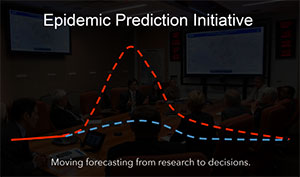The Epidemic Prediction Initiative
Executive Summary
 Timely epidemic interventions can prevent or control their adverse impact on human health. But prediction of epidemics is extremely challenging. For example, the incidence of dengue – a vector-borne disease affecting approximately 100 million people per year – can increase 3-5 fold during an epidemic, yet no clear indicator of the intensity or timing of an epidemic exists until it is already underway.Influenza and other globally important diseases present similar challenges. Advances in predictive modeling (e.g. forecasting) for these diseases and others are continually occurring, but predictions have not had the timeliness, accuracy, or reliability to be used regularly in public health decision-making.
Timely epidemic interventions can prevent or control their adverse impact on human health. But prediction of epidemics is extremely challenging. For example, the incidence of dengue – a vector-borne disease affecting approximately 100 million people per year – can increase 3-5 fold during an epidemic, yet no clear indicator of the intensity or timing of an epidemic exists until it is already underway.Influenza and other globally important diseases present similar challenges. Advances in predictive modeling (e.g. forecasting) for these diseases and others are continually occurring, but predictions have not had the timeliness, accuracy, or reliability to be used regularly in public health decision-making.
Epidemics of infectious diseases regularly affect populations throughout the world. Reducing the impact of epidemics through public health interventions like vaccination is costly and time-sensitive, and early and accurate epidemic predictions could aid in decisions related to their implementation. The project team identified numerous challenges that hinder the development of epidemic predictions for public health decision-making, limiting their use for public health decision-making. The first is that the interaction between model developers and public health decision-makers is limited, leading to difficulties in identifying and specifying relevant prediction targets that would best inform decision making. Second, data for making and evaluating predictions are often hard to share, hard to obtain, and hard to interpret. Lastly, no common standards exist for evaluating models, either against each other or against metrics relevant to decision-makers, making it difficult to evaluate the accuracy and reliability of predictions. All of these factors limit model development, application, adoption by decision-makers, and their eventual public health impact.
The Innovation: The team developed a web-based platform that will specifically address these obstacles and help connect research on epidemic prediction to public-health decisions. Material from CDC’s Predict the Influenza Season Challenge was used for the pilot phase during HHS Ignite.
A project supported by the: HHS Ignite Accelerator
Team Members
Michael Johansson (Project Lead), CDC/NCEZID
Matt Biggerstaff, CDC/NCIRD
Milestones
May 2014: Project selected into the HHS Ignite Accelerator
June 2014: Time in the Accelerator began
September 2014: Time in the Accelerator ended.
June 2015: Website added Dengue predictions in Beta
Project Sponsor
Hal Margolis, Branch Chief, Dengue Branch, Division of Vector-Borne Diseases, National Center for Emerging and Zoonotic Infectious Diseases (NCEZID), Centers for Disease Control and Prevention (CDC)


